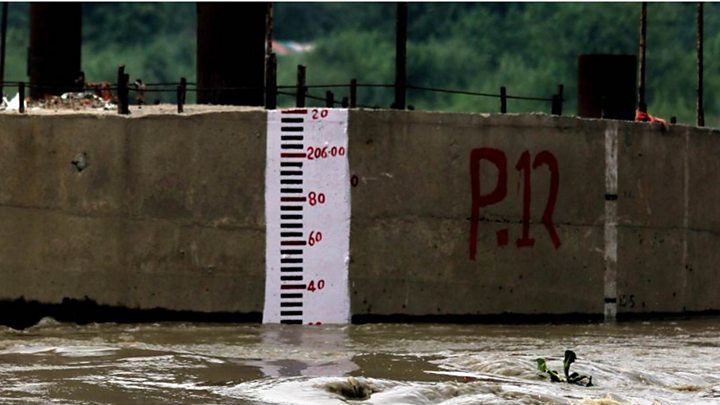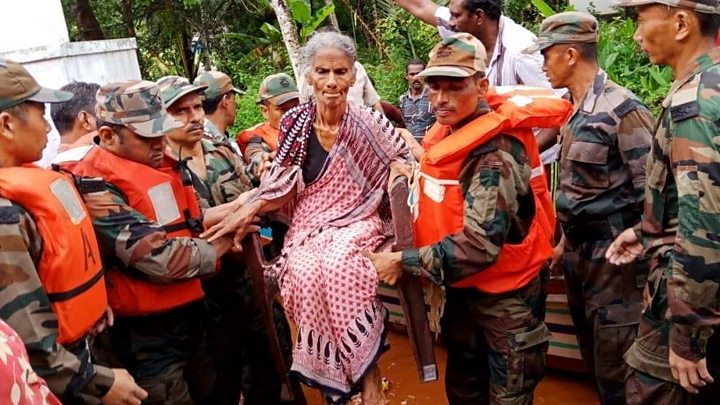 Image copyright
Indian Government
Image copyright
Indian Government
Indian Prime Minister Narendra Modi is in the southern state of Kerala to see for himself the devastation caused by what officials say is the worst flooding in a century.
He arrived late on Friday and is due to be flown over the worst-hit areas.
At least 324 people have been killed and more than 200,000 are homeless after weeks of rain triggered landslides and floods.
Troops backed by military helicopters are involved in a huge rescue effort.
More rain is forecast and a red alert in place. Strong winds are also predicted for Saturday and Sunday.
Across India close to 1,000 people have been killed in the current rainy season, which began in June, officials say.
"We are deploying more boats and the army to ramp up rescue operations," state government official PH Kurian told AFP news agency.
Helicopters have airlifted emergency supplies to many areas and special trains that carry drinking water have been sent to the state.
How serious is the flooding?
Kerala's chief minister, Pinarayi Vijayan, says the flooding as the worst the state has seen in 100 years.

He told reporters that more than 223,000 people were now living in more than 1,500 emergency relief camps set up in the area.
Parts of Kerala's commercial capital, Cochin, are under water, snarling up roads and leaving railways across the state impassable.
Some local plantations are reported to have been inundated, endangering the local rubber, tea, coffee and spice industries.

Schools in all 14 districts of Kerala have been closed and some districts have banned tourists, citing safety concerns.
What is the government doing?
Prime Minister Modi arrived in the state capital, Thiruvananthapuram, on Friday and flew to Cochin early on Saturday. He then chaired a meeting of officials to take stock of the situation.
He is due to conduct an aerial survey of the worst affected areas, Indian media reported.
The country's home minister has also offered his support for Kerala.
Anil Vasudevan, the head of the Kerala health disaster response wing, has said they are prepared to help victims and are setting arrangements in place to deal with the potential risks of water-borne diseases when the flooding recedes.
Why is the situation so bad?
It is normal for Kerala to get some of the country's highest rainfall during monsoon season, but the India Meteorological Department said it had been hit with 37% more than usual because of a spell of low pressure over the region.
Further downpours are forecast for the weekend, leading many to fear the situation may get worse.
Environmental scientists are also blaming deforestation, especially the failure to protect ecologically fragile mountain ranges in the area, local media report.
Mr Vijayan, the region's chief minister, has said the situation in Kerala has been made worse by neighbouring governments.
Earlier this week, he and his counterpart in Tamil Nadu entered a public spat over the release of water from a dam.
Kerala has 41 rivers flowing into the Arabian Sea, and 80 of its dams are now said to be open after being overwhelmed.
"Almost all dams are now opened. Most of our water treatment plants are submerged. Motors are damaged," Mr Vjayan said.
'Neck-deep water'
BBC Tamil's Pramila Krishnan spoke to people who had escaped the flooding in Cochin.
Krishna Jayan, 58, said she was at home sleeping when her friend woke her up.
"I opened the door and water gushed in," she said. "When we stepped into the street, we were neck-deep in water."
She said locals had tied ropes along the streets to help people walk through the water, allowing her and her friend to reach a bus to escape.